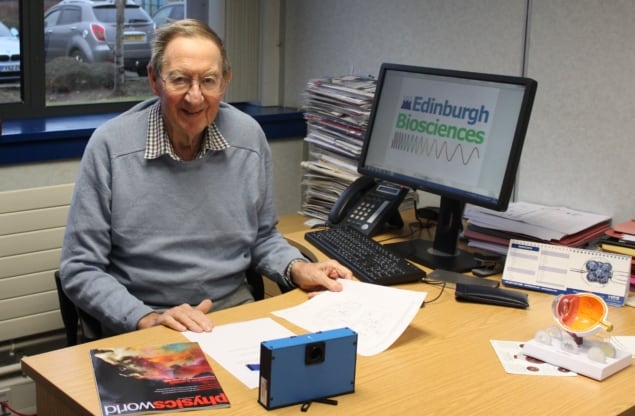
Edinburgh Biosciences, based in Livingston, Scotland, is on a mission to revolutionize the diagnosis and treatment of cataracts. Millions of people have cataract surgery every year and the benefits of developing a non-invasive, light-based procedure are compelling both for patients and healthcare providers.
As well as providing a quantitative diagnosis of the severity of visible cataracts, photonic tools being commercialized by the talented team of physicists, engineers and biochemists at the firm could warn of the condition in its early stages. The small-footprint spectrometers, designed in-house, feature compact light-emitting diodes (LEDs) and pave the way for gentle photo-bleaching of cataractous material as an alternative to surgery.
Edinburgh Biosciences believe that it is the first company to show that blue LEDs have the potential to replace more expensive, bulky and powerful lasers for rejuvenating cataractous eyes. The company has filed a patent application to register its claim (PCT/GB2016/053780).
We’re preparing to begin preclinical testing on complete living eyes, which will be a major step forwards in the programme.
Alan Kerr, chief scientist at Edinburgh Instruments
Lab tests on non-living lenses revealed that characteristic spectral transmission can be recovered using 430 nm fluorescence emission excited by a UV LED. Measurements also showed that light scattering is reduced in the treated specimens, which experts attribute to the reduction in the misfolded protein aggregates responsible for a cataract’s milky appearance.
It has been estimated that cost of conventional cataract operations worldwide could amount to more than £6 billion each year. Easy-to-operate LED-based units have the potential to deliver considerable savings by bringing the treatment to high-street opticians, minimizing the need for hospital visits and reducing the burden on the healthcare system. Because the instruments are portable and easily packed into a suitcase, they could play a huge role in providing eye care to the world’s population, whatever their location.
Technology development
Edinburgh Biosciences was formed as part of Edinburgh Instruments – a leader in spectroscopic instrumentation and gas detection solutions – to pursue biological applications of fluorescence spectroscopy. In 2011, the group’s R&D division was instrumental in the development of a novel interference filter together with partner company Delta Optical Thin Film of Denmark. The resulting wedge-profiled combination of optical coatings, which measures just a few centimetres in length, offers an elegant way of selecting precise colours (or wavelengths) of light from a beam passing through the filter.
An ultracompact solution, the filter’s spectral properties vary continuously along its length and allow instrument makers to miniaturize their designs. To give an example, when used with an LED light source, a linear variable filter can reduce the volume of a fluorescence spectrometer by more than 90%. The component’s development represents a key element in the Edinburgh Biosciences backstory, but it’s not the only one.
A major trigger for focusing on cataract diagnosis and treatment was a meeting between Professor Baljean Dhillon – Scotland’s only Professor of Clinical Ophthalmology and a consultant surgeon at Princess Alexandra Eye Pavilion in Edinburgh – and Desmond Smith, the founder of both Edinburgh Biosciences and Edinburgh Instruments. Smith, who was being treated for cataracts, was asked how he could use his photonics knowledge to advance eyecare. The discussion drove research into a quantitative tool that could help surgeons to determine more precisely the severity of a patient’s cataracts.
International network
Motivated by the prospects of photo-bleaching as a non-invasive method for treating cataracts, Edinburgh Biosciences initiated and led a EURO 2.6 million European Union project dubbed CATACURE to explore the technology in more detail. The programme ran from the beginning of 2014 to the end of 2016 and involved six partners across four European countries. Joining Smith and his team on CATACURE were experts from Glostrup Eye Hospital in Copenhagen, St Eriks Eye Hospital in Stockholm, Delta Optical Thin Film, HiTech Prontor of Germany and Heriot-Watt University, which is near Edinburgh Biosciences’ current facility.
“Building a strong network of partners is extremely important and we’re very excited by the results we’ve seen so far,” comments Smith. The company’s founder is a strong believer in the technology’s prospects and is backing the firm with his own money, thanks to the proceeds from the sale of Edinburgh Instruments to TECHCOMP EUROPE. Wai Shing Chen, a director of TECHCOMP, is also an early investor in Edinburgh Biosciences.
Buoyed by the success of the demonstrator unit, Edinburgh Biosciences is working towards its first human trials towards the end of 2019. It’s a busy time for the team. “Currently, we’re preparing to begin preclinical testing on complete living eyes, which will be a major step forwards in the programme,” says Alan Kerr, chief scientist at the company.
Market push
In 2018 the Scottish firm is looking to step up its push to market, which includes opportunities for new partners and investors. The company’s ultimate goal is to supply a combined diagnostic and non-invasive treatment tool for cataracts based on the successful CATACURE demonstrator. Core elements of the device also lend themselves to products in their own right.
A computer-controlled laser attenuator based on the novel linear optical filter is available to purchase now, and the product roadmap includes a wavelength selector followed by a miniature spectrometer. A fluorescence scanner for screening surgical instruments – a successful collaboration with the University of Edinburgh and one of the company’s first R&D products – also represents another revenue opportunity for this ambitious and talented firm.
Visit the Edinburgh Biosciences website for more details, and to get in touch with the team.




